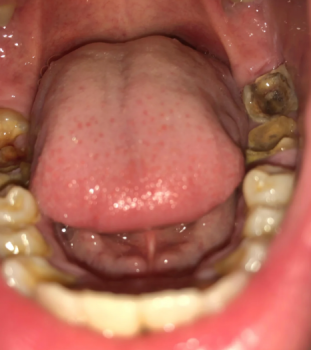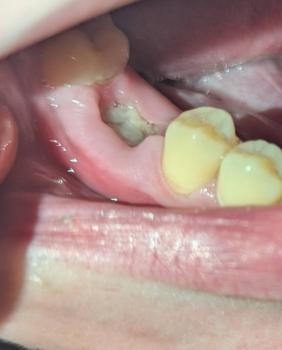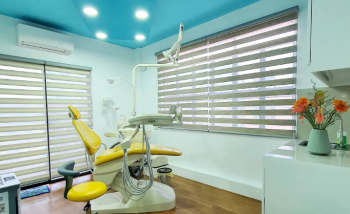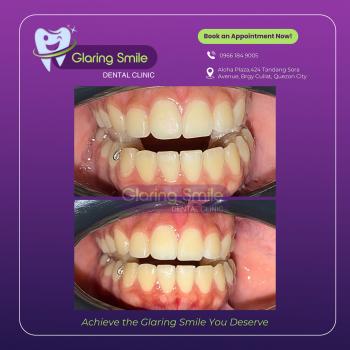We Bring Back the Sparkle in Your Smile.
Teeth Relapse After Braces: Causes, Diagnosis, and 14-Day Recovery Plan for Crowded Lower Teeth
Severity:
Teeth Problems:
Quick visual observations (what the photo suggests)
-
Lower anterior crowding: the six lower front teeth are pushed/overlapped and rotated — a classic relapse after braces when retainers aren’t worn.
-
Incisal wear/chipping on some lower incisors (flat, shorter edges) — likely from abnormal contact or grinding.
-
Yellowish deposits near the gumline on some teeth — looks like plaque/tartar (calculus) buildup.
-
Gum appearance in the photo looks OK for now but crowding makes cleaning difficult, increasing risk of gum disease.
I can’t count your current/extra teeth removal history from the photo. From appearance, this looks like relapse (teeth shifting back) rather than “extra” teeth coming in.
Why this happened
-
Retainer noncompliance is the most common reason — teeth slowly move back toward their original positions after braces if retainers aren’t worn.
-
Natural aging and jaw growth changes can also shift teeth.
-
Habits (tongue thrusting, nail biting, lip posture) or tooth loss elsewhere can alter tooth position.
-
If you had many extractions as a kid, the bite balance may be more sensitive to relapse.
What a dentist / orthodontist will likely recommend
-
Full clinical exam + X-rays (panoramic and bitewings) to check tooth roots, bone, and any hidden issues.
-
Professional cleaning (scaling) to remove tartar/plaque and restore gum health.
-
Orthodontic retreatment options:
-
Fixed braces (traditional) — predictable for crowded cases.
-
Clear aligners (Invisalign/clear trays) — possible depending on severity.
-
Retreatment length typically 6–24 months depending on how much movement is needed.
-
-
If crowding is severe or bite problems exist: interproximal reduction (IPR) (minor enamel reshaping), or rarely a tooth extraction if space is needed.
-
Retention plan afterward (lifelong or nightly retainer wear) — crucial to avoid relapse.
-
If anxiety is severe: sedation dentistry options (nitrous oxide, oral sedative) to make visits tolerable.
What can be done in 14 days (realistic short-term plan)
Days 0–3
-
Improve home cleaning: soft toothbrush + fluoride toothpaste twice daily, floss daily (or interdental brushes for tight areas).
-
Use an alcohol-free mouthwash if tolerated.
-
Start reducing sugary foods/drinks.
Days 3–7
-
Book and attend a dental exam + professional cleaning. Cleaning removes calculus that’s feeding gum inflammation and makes the teeth look worse.
-
Dentist will likely take intraoral photos and x-rays at this visit.
Days 7–14
-
Review treatment options with dentist/orthodontist. They may:
-
Offer an orthodontic consultation and digital scan/impressions.
-
Start planning — for some cases, a simple removable retainer or limited orthodontic movement can begin quickly; for full treatment, a start within 2 weeks is common after planning.
-
-
If gum inflammation or infection is present, treatment (deep cleaning) may continue and healing of gum tissues may begin within 1–2 weeks.
What actually “heals” in 14 days: soft tissue (gums) often show noticeable improvement after cleaning and better home care; but tooth alignment will not be corrected in 14 days — orthodontic tooth movement takes months.
If you delay treatment — what gets worse
-
Increased risk of cavities in the crowded/overlapping areas (harder to clean).
-
Worsening gum disease (gingivitis → periodontitis) which can cause bone loss and tooth mobility.
-
More tooth wear and chipping from abnormal bite forces.
-
Treatment complexity and cost may increase (longer orthodontic treatment, possible extractions).
-
If infections develop, that can lead to pain and more urgent care.
Practical step-by-step process I recommend now
-
Book a gentle dentist (look for “sedation dentistry” or “anxiety-friendly” in reviews). Use your directory: https://cebudentalimplants.com/map-dental-clinic
-
At first appointment: get exam + full set of x-rays + professional cleaning.
-
After diagnostics: see an orthodontist for options (braces vs aligners vs minor IPR).
-
Decide on a plan and ask about retention options before starting (important!).
-
Follow the retention plan strictly once active treatment ends — nightly retainers are often recommended forever.
Managing dental anxiety
-
Tell the clinic up front that you’re terrified — they can schedule a short “meet and greet” first.
-
Ask about nitrous oxide (laughing gas) or oral sedatives for the appointment.
-
Bring a friend, use calming music, practice breathing techniques.
-
Start with cleaning/consultation to build trust before major procedures.
Short message you can paste to a dentist (handy)
Hi — I had braces as a child but stopped wearing my retainer. My lower front teeth have relapsed and feel crowded; there is some yellowing near the gumline. I’m anxious about dental visits. Could I book an exam, x-rays, and a cleaning, and please advise on orthodontic retreatment options and sedation choices?
Final notes / recommendations
-
This looks like relapse rather than an extra tooth problem — treatment is usually straightforward but requires time.
-
Prioritize a cleaning + x-rays within the next 1–2 weeks to prevent gum/cavity problems.
-
Orthodontic correction will improve long-term function and hygiene but expect months of treatment, followed by strict retainer wear.
-
Use the directory link you posted to find clinics nearby and pick one that mentions patient comfort/sedation.













